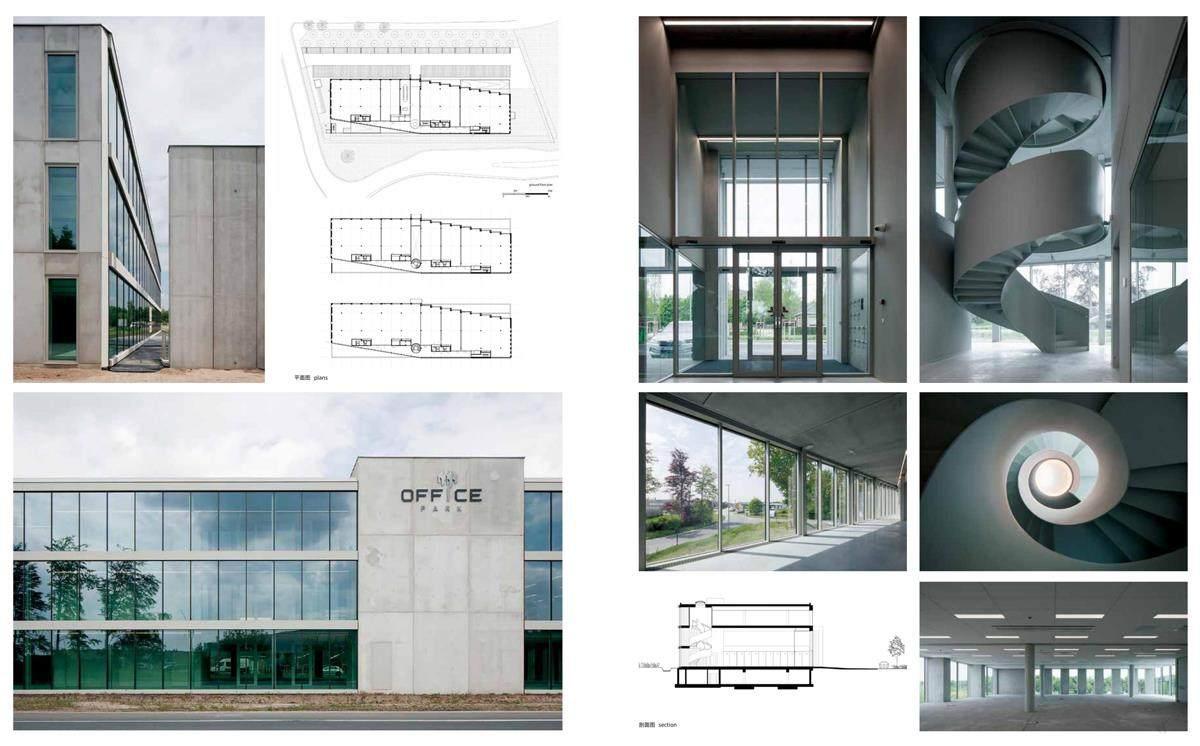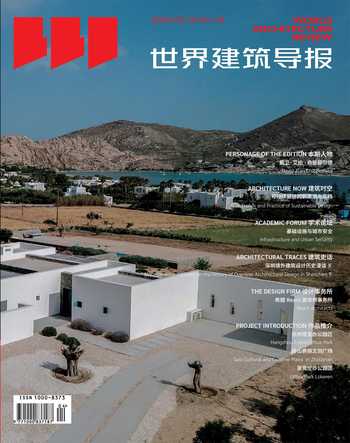洛克倫辦公園區(qū)


設(shè)計單位:NWLND Rogiers Vandeputte
項目位置:比利時洛克倫
建筑面積:4,880平方米
竣工日期:2022年
攝影師:Johnny Umans
Architects: NWLND Rogiers Vandeputte
Location: Lokeren, Belgium
Area : 4,880 m?
Year : 2022
Photographs: Johnny Umans
辦公園區(qū)是在工業(yè)綜合體和郊區(qū)住宅之間的過渡時期開發(fā)的。該項目將場地從北向南排列成長條形:面向城郊社區(qū)的綠色緩沖區(qū)、停車場、80米長的建筑區(qū)以及沿主干道一側(cè)的自然滲水溝渠。四個核心被放置在一個位于建筑區(qū)域的簡單結(jié)構(gòu)中。
它們偏離中心的位置創(chuàng)造了沿著建筑南立面的狹窄區(qū)域和面向北邊的更深區(qū)域。這個狹窄的區(qū)域是主要的流通區(qū)域,為核心之間的辦公單元提供通道。它朝南,靠近嘈雜的高速公路,使其能夠作為辦公單位的噪音和熱量的緩沖。這個自然氣候緩沖帶位于室內(nèi)外之間,作為每個樓層四個單元之間的非正式會面和互動空間。在這個緩沖區(qū)和雙層高入口大廳的交匯處,有一個巨大的鋼制螺旋樓梯,邀請?zhí)剿鞲叩臉菍樱陌凳究梢酝ㄟ^南立面瞥見,但它的存在尤其值得注意的是從建筑的北側(cè)入口處。
南立面作為建筑的代表立面,完全采用玻璃材料,北、東、南立面由樸素的混凝土框架和寬大的窗戶組成。通過接縫、窗戶和屋頂邊緣的具體細(xì)部,工業(yè)混凝土外墻變得相當(dāng)精致。體量角落的移動引入了一個沿著停車坡道的特殊階梯立面。
辦公空間的特點是簡樸大方。辦公室大部分朝北,通過天花板高的窗戶,以及循環(huán)帶的緩和南部光線,減少了冷卻所需的能量,并受益于充足的日光。 建筑及其立面連接解決了方向和位置問題。剝離區(qū)域的組織創(chuàng)造了一個不規(guī)則的辦公建筑——即一個沒有中央核心的辦公室——其中的集體流通成為一個生動的立面。這個集體空間與高入口大廳一起,形成了租客公司之間會面和互動的中心。
可持續(xù)技術(shù)的整合,建筑的朝向和徹底的隔絕最大限度地減少能源消耗,消除對化石燃料的需求。合理的結(jié)構(gòu)和辦公樓層的自由高度允許在短期內(nèi)輕松修改布局,并可長期將其他項目納入建筑。
Office Park is developed during the transition between an industrial complex and suburban housing. The project organized the site in long strips running from north to south: a green buffer zone facing the suburban neighborhood, a strip of parking, an 80-meter-long building zone, and a ditch for natural water infiltration along the side of the main road. Four cores are placed within a simple structure sitting in the building zone.
Their off-center position creates a narrower zone along the southern facade of the building and deeper zones facing the north. This narrow zone is the main circulation zone, providing access to the office units in between the cores. Its south-facing orientation and its proximity to the noisy highway allow it to function as a buffer for noise and heat for the office units. Sitting between inside and outside, this naturally climatized buffer zone serves as an informal space for meeting and interacting shared between the four units on each floor. On the intersection of this buffer zone and the double-height entrance hall sits a mighty steel spiral staircase. An invitation to explore the higher floors, a hint of it can be glimpsed through the southern fa?ade, but its presence becomes especially noteworthy upon entrance from the north side of the building.
While the south facade acts as the representative fa?ade of the building and is completely glazed, the north, east, and south facades are formed by an austere concrete framework and generous windows. Through specific detailing of the joints, windows, and roof edge the industrial concrete facades become quite refined. The shift of the corners of the volume introduces a particular stepping facade along the parking ramp.
The office spaces are characterized by their spartan generosity. The offices are mostly oriented towards the north which reduces the energy required for cooling and benefits from abundant daylight through the north-facing ceiling-high windows, and from tempered southern light via the circulation strip. The building and its fa?ade articulation negotiate their orientation and location. The organization of stripped zones creates an atypical office building – that is to say, an office without a central core – in which the collective circulation becomes a lively facade. This collective space, together with the high entrance hall, forms a hub for meetings and interaction between the tenant companies.
The integration of sustainable techniques, the orientation of the building, and the thorough insulation minimize energy consumption, eliminating the need for fossil fuel. The rational structure and free height of the office floors allow for the easy modification of the layout in the short term, and for the long-term incorporation of other programs in the building.

